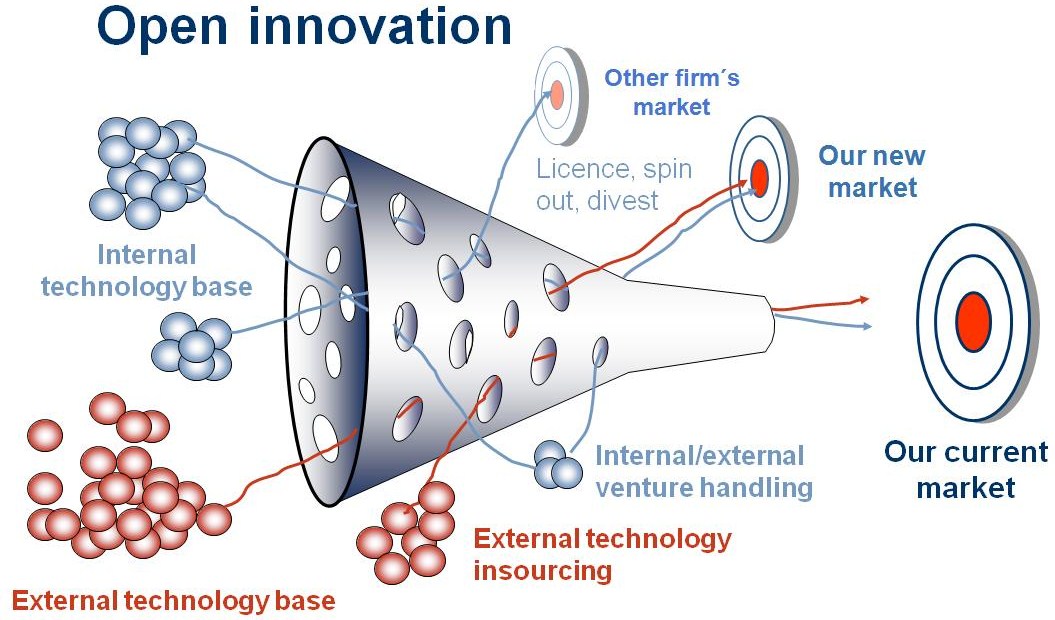Innovation: What is Open Innovation?
Open Innovation is a recent created trend for a company to be successful in terms of innovation. It changes former habits on how to be creative and how to create ideas. When I first thought about Open Innovation in our class, one case came into my mind. It was the way how the London Olympics logo was chosen. At first well known designers were paid to create a logo. After their work was shown, nobody actually liked it. What happened is that a national contest was organized and any Brit could send his project. Finally a young man Reiss Evans’s design was chosen. The costs of the contest amounted to $500 (costs of creating the necessary website).

The professional designers logo

The logo chosen after the national contest
As far as the scientific definition is concerned I liked the most the one proposed by Henry Chessbrough in his book “Open Innovation: Researching a New Paradigm.” He states that: “Open innovation is the use of purposive inflows and outflows of knowledge to accelerate internal innovation, and expand the markets for external use of innovation, respectively. [This paradigm] assumes that firms can and should use external ideas as well as internal ideas, and internal and external paths to market, as they look to advance their technology.”
The basic idea of Open Innovation is to change our previous common believes that by revealing our ideas somebody will steal them. The new believes are or should be that by revealing our ideas we can improve them or connect them with other ideas to create a final version of a certain innovation implementation. The idea of connecting two hunches was explained in the RSA video “Where the good ideas come from?” made by Steven Johnson.
This process can also be good for a company reputation and its relations with clients/customers. They may feel important for the company and actually feel as they contribute to the company’s development.
Within the Open Innovation paradigm there are three techniques that may be used to implement it into a company’s strategy. The first one is crowd-sourcing, which is outsourcing tasks normally conducted by an employee. Normally the outsourcing is targeted to customers, clients or users to receive ideas, comments, complains or any kind of information to improve the company’s product or service. It is a very useful tool, when it is used wisely. Sometimes company confuse it and try to use it as a marketing tool. Another technique is the user-driven innovation. It consists of a careful observation of users activity in order to obtain information that can be used in the innovation process. It is important to analyze users habits and behavior in order to transform into useful information. The third and last technique is co-creation. It is a process of opening a

A simple scheme shoing how Open Innovation works
panel for other companies and customers to discuss, share, combine and renew ideas to create value through learning mechanisms. Companies nowadays cannot exist without customers. The sooner the company is asking customers for their contribution the better for its performance. Nowadays there are a lot of companies that are being created, which are called Open Innovation intermediates, e.g. Spigit, The iBridge Network, Innovation Exchange and many others.
The most innovative companies in the world have used many different techniques to implement innovative ideas. IBM for instance was one of the first companies that have implemented a new work environment. They believe that innovation in the XXI century is not anymore about products but about business models and how to keep your customers loyal. Apple also has follow this business model and has become a specialist in that field. Who (from it’s users) does not love this products? Toyota on the other hand started to specialize in manufacturing processes. All of those examples are different but all where based on Open Innovation paradigm. All of those companies have created a sharing panel in order to connect one hunch with the other one.
References:
1. Lindegaard, S., “Making Open Innovation Work”, 2011
2. “The World’s Most Innovative Companies”, retrieved from http://www.businessweek.com/print/magazine/content/06_17/b3981401.htm?chan=gl
3. Chesbrough, H., “Open Innovation: Researching a New Paradigm”, 2006




.png)
].gif)
.png)
].png)
].png)
].png)
.png)
].png)
.png)
